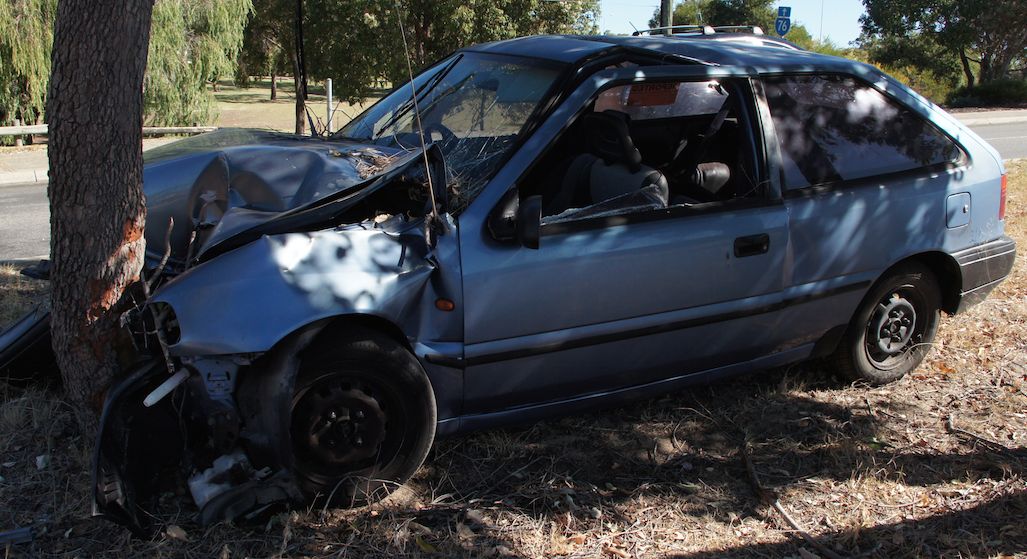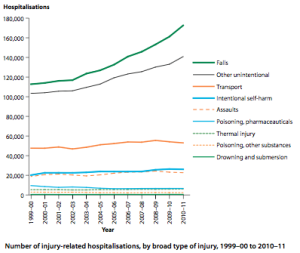The nature of the problem
An injury is an adverse affect on the body resulting from an event. They include accidents such as: falls, transport accidents, and drowning; as well as intentional events such as: suicide, homicide or assault (known as external causes of injury). Injuries are a significant cause of mortality and morbidity in Australia.
Extent of the problem (trends)
Injuries account for 7.6% of all deaths. 1/3 of male deaths and almost 2/3 of female deaths occurred in the elderly. Injuries are the highest cause of death in those under 35 years of age. Most deaths related to injuries result from falls, self-harm and road accidents. The injury death rate has remained fairly constant over the last 10 years. For most external causes of injury death the rates have been declining, including the rates for transport, thermal (fire related), drowning, suicide and homicide.
5% of all hospitalisations are for injuries, with the elderly being the group presented most often. Males are more likely to be hospitalised for injury than females and: falls (40%), other unintentional injuries (33%) and transport injuries (12%) were the most common causes. Over the last 10 years injury related hospitalisations have risen by 1% each year.
Risk factors and protective factors
Risk and protective factors for injuries vary depending on the type of injury sustained and its major cause.
Falls – major risk factors for falls include being elderly, poor balance or working in a high-risk job, such a building, or roofing, where falls can be more frequent. Some falls can be prevented through the use of harnesses and other WH&S related safety regulations.
Transport – risk factors for transport injuries include: speeding, drink driving, and fatigue. Protective factors fort transport injuries include: wearing a seatbelt, going the speed limit, wearing a helmet, and ensuring long road trips are broken up into manageable chunks where fatigue does not become a dangerous factor.
Self-harm – risk factors for self-harm include: mental health issues, depression, drug used, unemployment, and powerlessness. Protective factors include the development of resilience, employment, and a positive sense of self.
Work – risk factors include: poor attitude to safety, unsafe work behaviours, and working in high risk jobs such as transport, construction or mining. Protective factors include: the use of protective measures, risk assessments, and proper utilisation of WH&S legislation and the WorkCover Authority.
The sociocultural, socioeconomic and environmental determinants
Sociocultural determinants of injuries include: family, peers, culture, religion and media. Risk taking is very high amongst youth, particularly in males, this risk taking overflows into transport and young male drivers attitudes on the road where they maintain the highest fatality rate. Young males also maintain the highest suicide fatality rate. The media has been utilised to help address many of the injury related mortality and morbidity issues, including road safety and mental health issues.
Socioeconomic determinants of injuries include: employment, education and income. People from low socioeconomic backgrounds are more likely to suffer serious injury, this is particularly true if they also are employed in work that is considered more dangerous. People who are less education and hove lower income levels are less likely to afford safety devices or new model cars with higher road safety ratings, leaving them more at risk of serious injury. People who arte employed in the labour or blue-collar work force are more likely to suffer injury, particularly in building and transport.
Groups at risk
Groups at higher risk for injury than other Australians include:
- ATSI, who have higher rates for transport, violence, falls and drug related injury
- Young children
- People under 44, where injury accounts for almost ½ the deaths
- Males between 15-25 years of age, particularly for transport injury
- Unsafe drivers, particularly speeding or fatigue.
- Workers in high-risk employment
- People in rural and remote locations, due to the nature of their work and the greater distance to emergency services. They also have higher rates of road accidents and fatalities.
- The elderly


